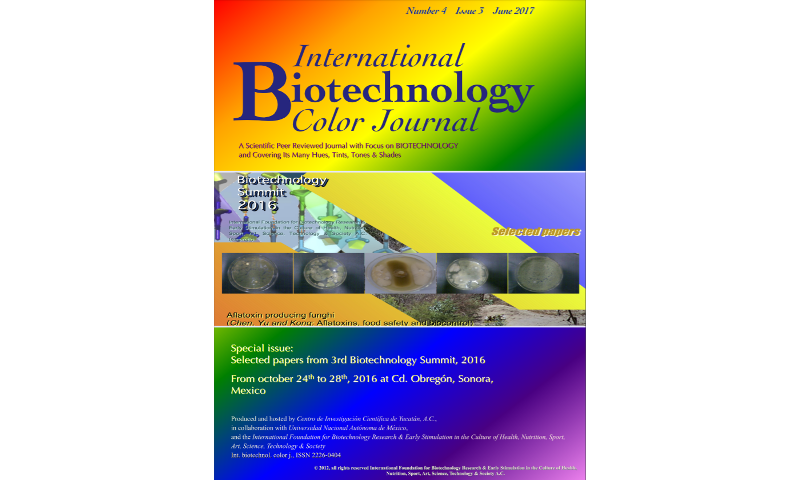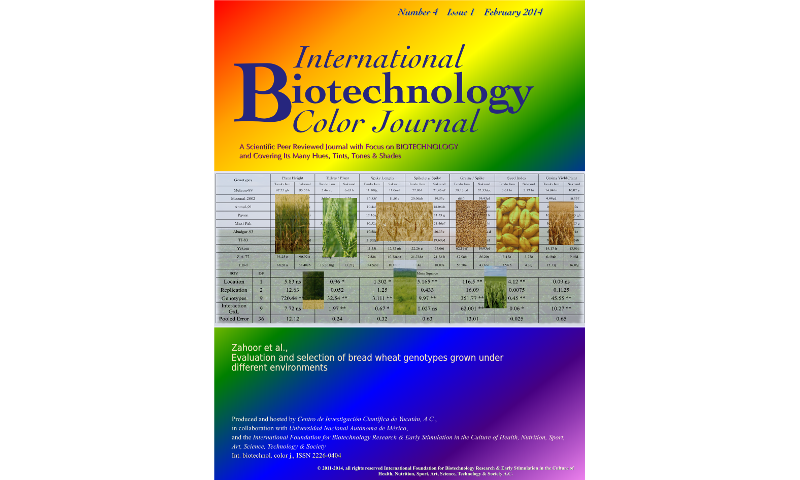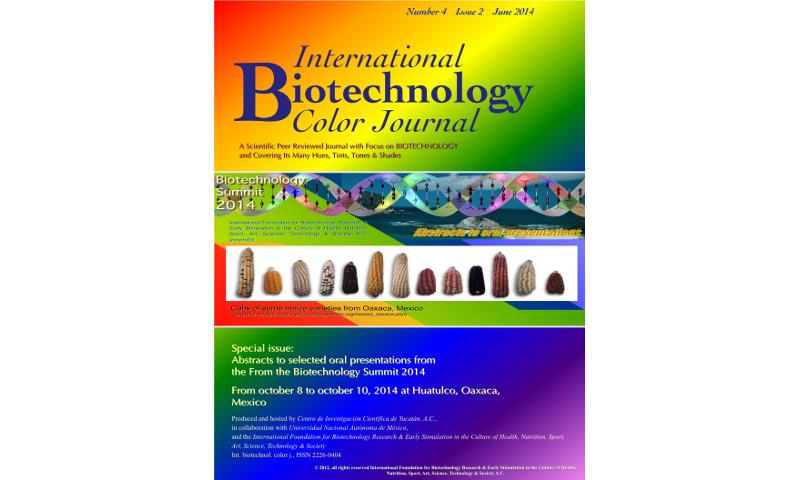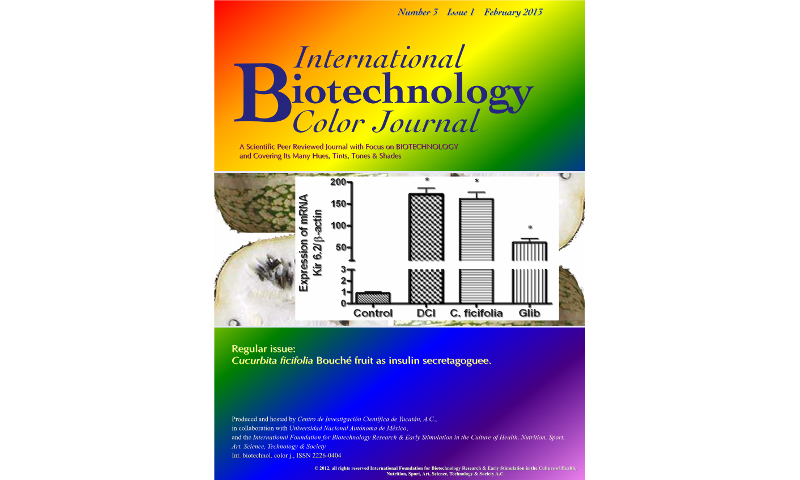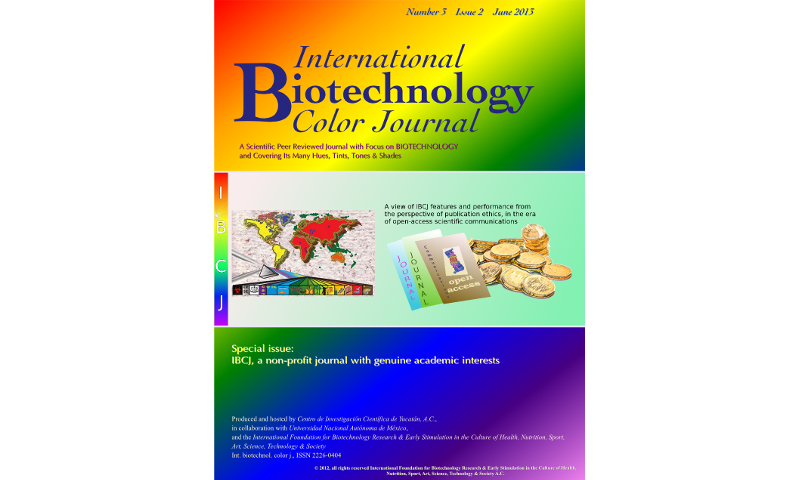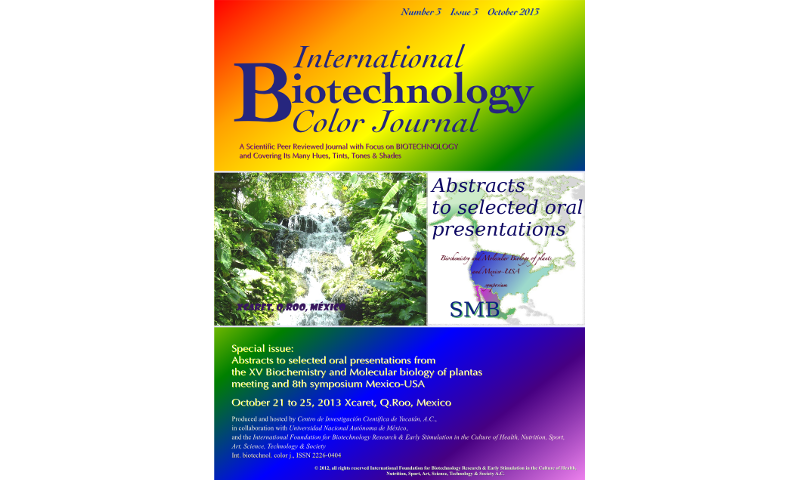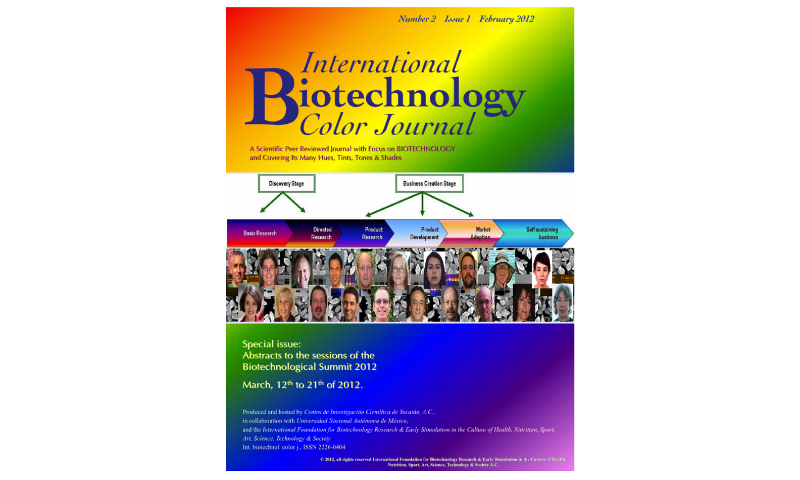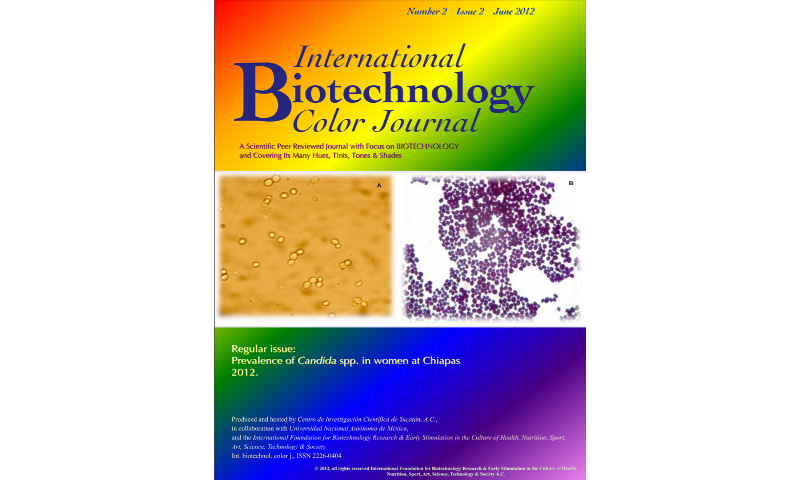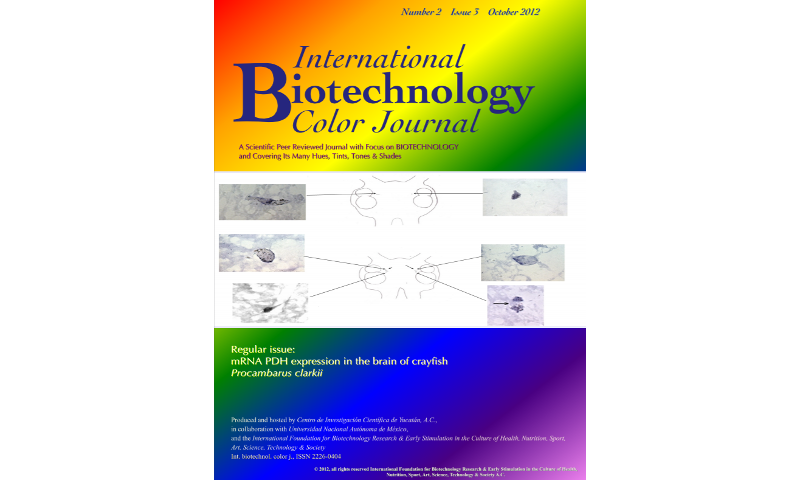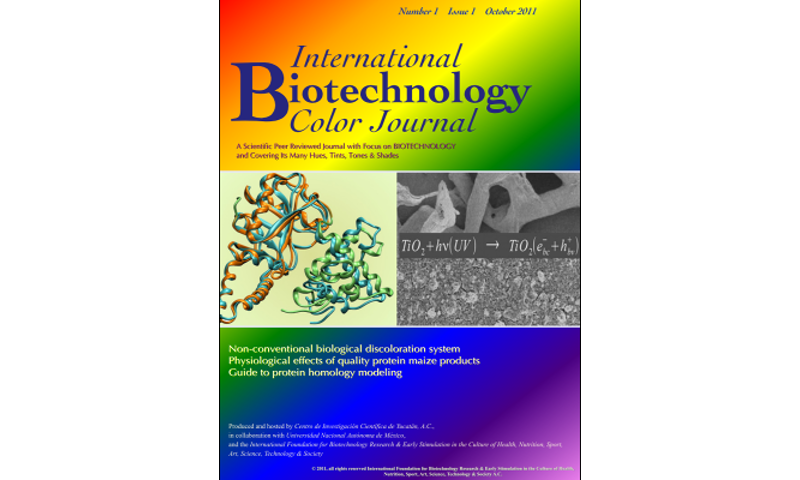The International Biotechnology Color Journal (IBCJ) is the official trimonthly scientific Journal of the International Foundation for Biotechnology Research & Early Stimulation in the Culture of Health, Nutrition, Sport, Art, Science, Technology & Society A.C., a nonprofit corporation. IBCJ is devoted to facilitating the advancement of our understanding of Biotechnology (The application of science and technology to living organisms, as well as parts and models thereof, to alter living and non-living materials for the production of knowledge, goods and services). IBCJ iscommitted to publishing original contributions of research in all areas related to the theory and practice of biotechnology in its broadest context (organized by color), including research articles and notes, critical reviews,essays, book reviews, letters, correspondence, and news features or views. IBCJ provides an excellent resource for the publication of peer-reviewed research papers with proven or likely implications for the past, current, and future practice of biotechnology.
Authors should suggest the section in which their work is best placed:
- Blue Biotechnology. Marine (aquatic) biotechnology: aquaculture, coasts and sea, fish health and nutrition, aquatic animals reproduction, cloning and genetic modifications, aquaculture and fisheries pests and disease control.
- Brown Biotechnology. Desert biotechnology: space and geomicrobiology, arid zone & desert biotechnology.
- Dark Biotechnology. Bioterrorism: human and animal pathogen control, bioterrorism, biowarfare, biocrimes, anticrop warfare.
- Gold Biotechnology. Bioinformatics: nanobiotechnology, microelectronic and microelectromechanical systems (MEMS), micro systems technology (MST), nano electro mechanical systems (NEMS) micromachines.
- Green Biotechnology. Agricultural biotechnology: biotechnologies for the production, processing, and storage of agricultural and livestock production, biofertilizers and agrobiochemicals, agricultural pests and disease control, ecology and rational wildlife management, preservation of biodiversity, plant, pet, and farm-animal disease, health, nutrition, reproduction, cloning, and genetic modification, plant micropropagation and plant tissue culture, bioremediation & environmental biotechnology, sustainable design, renewable energy generation: resource saving and energy efficient; bioremediation & environmental biotechnology; bio-fuel production and sustainable biotechnology development; biotechnology for competitive production; new material; and new energy sources.
- Grey Biotechnology. Classical biotechnology (fermentation): industrial biotechnology: classical fermentation & bioprocess/bioengineering technology; engineering and technological equipment for bioproduction; output of science-intensive bioproducts.
- Purple Biotechnology. Patents, IPR: strategy for intellectual property protection, patents, publications, inventions.
- Red Biotechnology. Medical biotechnology: human health & disease, novel medical diagnostics and tissue engineering.
- White Biotechnology. Industrial biotechnology (gene-based).
- Yellow Biotechnology. Nutritional biotechnology: food, nutrition science and neutraceuticals.
- Platinum Biotechnology. Synthetic biology.
- Iris Biotechnology. Multidisciplinary area: biochemistry, molecular biology & biotechnology, applications based on omic´s.
- Transparent Biotechnology. Bioethics, biotechnology, and society: tools for assessment of the support to the scientific sector, including its biotechnological potential and human resources.
- Silver Biotechnology. Biobusiness, bioentrepreneuship & marketing: Development economics, biobusiness and marketing: strategy for innovative development of the national economy;, improvement of the system of the S&T and innovation activities management.
- Indigo Biotechnology. Integrating science, education and manufacturing. education & early childhood stimulationin the culture of health, nutrition, sport, art, science, biotechnology & society as information and telecommunication technologies TIC´S.
AUTHOR GUIDELINES:
IBCJ will include current trends in scientific publication for the electronic format and international requirements for indexing. Authors have the total responsibility for data published.
Submitted manuscripts will be initially evaluated by the professional IBCJ Editors, the IBCJ editor will determine if the manuscript is within the journal scope, has high scientific quality, is presented in a manner suitable for publication in a scientific peer-reviewed journal, the content has not been published elsewhere, and if it has not been previously rejected by this journal. If the submission is considered to meet all of the above criteria, it will be forwarded to additional to referees with enough expertise in the field, for further review. Referee’s names will not be disclosed, but their comments will be forwarded to the authors.
Authors must transfer the copyright of their article for International Foundation for Biotechnology Research & Early Stimulation in the Culture of Health, Nutrition, Sport, Art, Science, Technology & Society A.C.
MANUSCRIPT SUBMISSION
The manuscript should be sent in electronic form as both a Microsoft Word file and a PDF file to:ibcj_eb@hotmail.com
Accompany your manuscript with a cover letter suggesting the names and e-mail addresses of three potential referees, and the name of a member of the Editorial Board or the Advisory Editorial Board for manuscript assignment. The choice of editor should match the area (color) where the submitted contribution it to be included, if accepted. Authors should contact the editor if no acknowledgment receipt has been received after a six working days. Authors may also indicate the name of potential referees which they wish to exclude. The final choice of referees will be made by the assigned editor. If the assigned editor considers essential to include a reviewer, that the author has requested to exclude, the editor will first consult the corresponding author, who may then withdraw its submission request.
Graphic abstract is limited to 5 cm by 10 cm (length by width). Pages should be numbered and lines should be numbered and double-spaced; use Times New Roman font, 12 points size. Sections titles must be preceded by three blank lines. Paragraphs must have a four-space indention. Page size letter (21.5 x 28 cm) with 2.5 cm margins all round. The illustrations can be figures, schemes, charts, tables, graphics. Illustrations should be submitted as digital documents in TIFF, .JPG, or Post Script formats, and in the actual size for final version to fit in one (1962 pixels, i.e. 3.27 inches width) or two (4098 pixels, i.e. 6.83 inches width) columns with, 600 dpi resolution. Avoid figures larger than 1 page (4800 pixels height). If essential, the figure must be split into 1 page blocks (4098×4800 pixels). Tables and illustrations graphs, and other material are to be submitted separately to the text. Tables should include a Table heading and, if necessary, footnotes. Illustrations should have captions, which should be provided separate to the text. Both, table headings and illustration captions should start with a brief descriptive title, and include a short description of the contents and those experimental or technical details that are essential to the unambiguous interpretation of the data. All scientific data should be presented according to the International Units System (SI). When the introduction of a new unit of measurement is required, the unit should be clearly defined in the manuscript, base your new definitions on the SI system, as much as possible.
- CONTRIBUTION ARTICLES. Manuscripts in this category must include the following sections: Title, Authors, Authors affiliations, Contact address, phone number and e-mail of the corresponding author, Running title (60 characters maximum), Abbreviations, Abstract, key words, Introduction, Materials and Methods, Results, Discussion, Conclusion, Acknowledgmentsand References. The manuscript should present results of a complete, original and verifiable research. In regular manuscripts, text should be no more than 10 pages, including tables and figures and references. With a charge to the authors, longer papers may be accepted, if the scientific value of the paper does justify so.
- NOTE. Notes must include the sections: Title, Authors, Authors affiliations, Contact address, phone number and e-mail of the corresponding author, Running title (60 characters maximum), Abbreviations, Abstract, key words, Introduction, Materials and Methods, Results, Discussion, Conclusion and References. Manuscripts should present relevant findings, detail a brief contribution, the results of modification or improvement of previous work, or forward a novel model. Text should not be more than 3 pages. Longer contributions of this sort will not be accepted, as they will be considered as a contribution article.
- ESSAY. This contributions must include the sections: Title, Authors, Authors affiliations, Contact address, phone number and e-mail of the corresponding author, Running title (60 characters maximum), Abbreviations, Abstract, key words, Introduction, Discussion, Conclusion and References. Essays should present critical and/or analytical contribution. Text should not be more than 5 pages.
- BOOK REVIEW. Book reviews must focus on books recently published or in press, that contribute to some relevant aspect of Biotechnology. No sections are required, and the text should not be more than 1 page. Book reviews must present a critical and concise view of the contents and value of a recently published book.
- LETTERS TO THE EDITOR This contributions must include the sections: Title, Authors, Authors affiliations, Contact address, phone number and e-mail of the corresponding author, Running title (60 characters maximum), Abbreviations, Abstract, key words, Introduction, Discussion, Conclusion, Acknowledgmentsand References.Letters to the editor should deal with topics of high relevance and/or novelty, or those of a polemical nature in any of the color areas listed above. The should be supported by appropriate recent references, and offer a novel point of view to the issue they address.
- CORRESPONDENCE. No sections are required, and the text should not be more than 1 page. Correspondence are brief comments to enrich or criticize a previous article published in the journal. This contributions will be accepted if the Editor considers the comment relevant and of interest to the readers of ICBJ. Personal views lacking scientific support will not be accepted.
- NEWS AND VIEWS. No sections are required, and the text should not be more than 2 pages. News and views are short comments of very recent findings published in the ICBJ, or in some other international journal. They should be brief, insightful, and well referenced.
About IFFBRAESITCOHNSASTAS AC Non Profit.
The International Foundation for Biotechnology Research & Early Stimulation in the Culture of Health, Nutrition, Sport, Art, Science, Technology & Society A.C. was founded in 2009 as a non-profit association to promote the development of professionals of biotechnology in research, industry, services, and education, and for the diffusion of biotechnological knowledge. Organizes the Biotechnology summit and Biotechnology color meeting for education that includes activities of current interest for the professionals and students working or interested in the areas of biotechnology. It also promotes the area of research, education, industry, and technological development. The International Biotechnology Color Journal (IBCJ) is the official trimonthly Journal of the International Foundation for Biotechnology Research & Early Stimulation in the Culture of Health, Nutrition, Sport, Art, Science, Technology & Society since 2011 and is devoted to the advancement of our understanding of Biotechnology (The application of science and technology to living organisms, as well as parts and models thereof, to alter living and non-living materials for the production of knowledge, goods and services). The instructions for authors appear on the last page of each issue.
We appreciate your support and your attention to this email message.
Best Regards
